A Brief Colonial History Of Ceylon(SriLanka)
Sri Lanka: One Island Two Nations
A Brief Colonial History Of Ceylon(SriLanka)
Sri Lanka: One Island Two Nations
(Full Story)
Search This Blog
Back to 500BC.
==========================
Thiranjala Weerasinghe sj.- One Island Two Nations
?????????????????????????????????????????????????Saturday, July 15, 2017
Elections for sale: who funds Britain’s political parties?
- By Martin Williams-14 JUL 2017
Behind the scenes of a general election, an army of supporters prop up the campaigns with millions of pounds.
Party funding has become a political football. Labour accused the Conservatives of being “as dependent as ever on finance and industry magnates to fund their campaign”. The Conservatives, in turn, claimed Labour’s campaign was “bought and paid for by militant unions”.
The biggest political donors include wealthy business leaders, powerful organisations and members of the nobility. But who are they, exactly? And how much of a stranglehold do they really have over politics?
This changed when the Electoral Commission was set up in response to a series of sleaze allegations in the 1990s.
Now days, if you donate more than £7,500 in one year, the political party has to publicly declare this.
The records show that political donations have increased significantly since 2001.
There was a dip after the Conservative-led coalition government was formed in 2010. But that was probably partly as another election was unlikely until 2015, so there was not an immediate need for extra cash.
Donations shot up again in 2014, hitting a record high last year. Altogether, politicians and political parties raised more than £88m.
This graph shows the total amounts that were registered with the Electoral Commission each year, across all the parties. (The 2017 figures are lower because the year is not complete and many donations already received have not been formally registered yet).

(It’s worth bearing in mind that these Electoral Commission figures only include donations from supporters who have donated at least £7,500. Also, these are just party donations – some donors may have given money to individual parliamentary candidates).
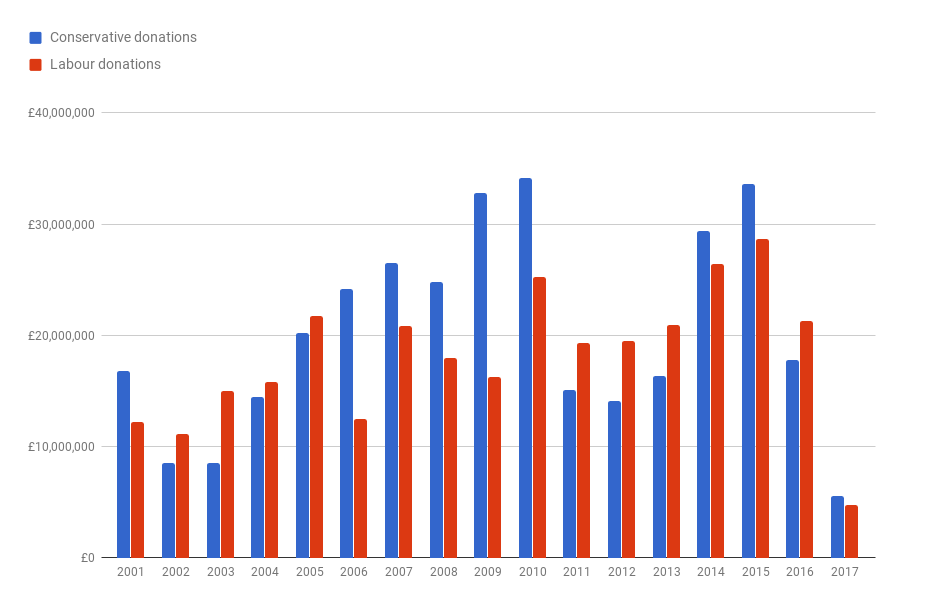 If we just look at the biggest donations of over £100,000, the difference between the two parties is striking.
If we just look at the biggest donations of over £100,000, the difference between the two parties is striking.
The number of large donations going to Labour has remained quite stable over the years. But large donations to the Tories come in peaks and troughs, which roughly align with general elections.
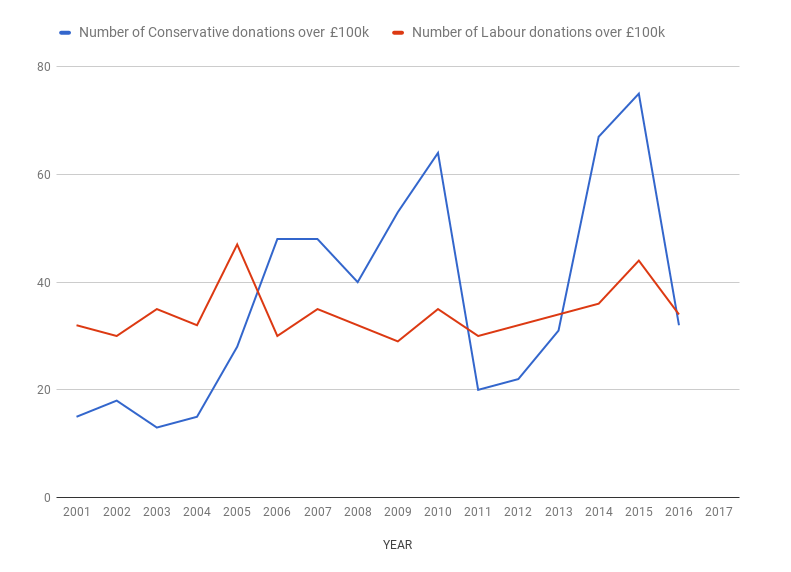
During this 52-day period, the Conservatives received nearly three times as much in declarable donations than Labour. In fact, 68 per cent of all declarable donations to any party went to the Conservatives.
This trend can be seen in other elections, too, with the Conservatives raising more during the same 52-period before an election. The notable exception is 2015, when Labour managed to raise about £750,000 more.
 The majority of money raised by political parties, after the 2017
election was called, came from individuals. Private companies and trade
unions made up the next two largest categories of donors.
The majority of money raised by political parties, after the 2017
election was called, came from individuals. Private companies and trade
unions made up the next two largest categories of donors.
However, these figures do not include smaller donations that don’t have to be declared.
Labour told FactCheck they raised £5m in small donations over the 52 days before the election. Of that, £4m came from online donations.
We can’t independently verify Labour’s figures but it seems the overall gap between the two main parties’ donations could be much less once small donations are accounted for.
We asked the Conservatives how much they raised in small donations, but have not received a reply. We will update this if they provide the figures.
There’s a lot of truth in this, but the majority of Labour’s funding actually comes from other sources.
Here’s a breakdown of Labour donations registered in 2016.
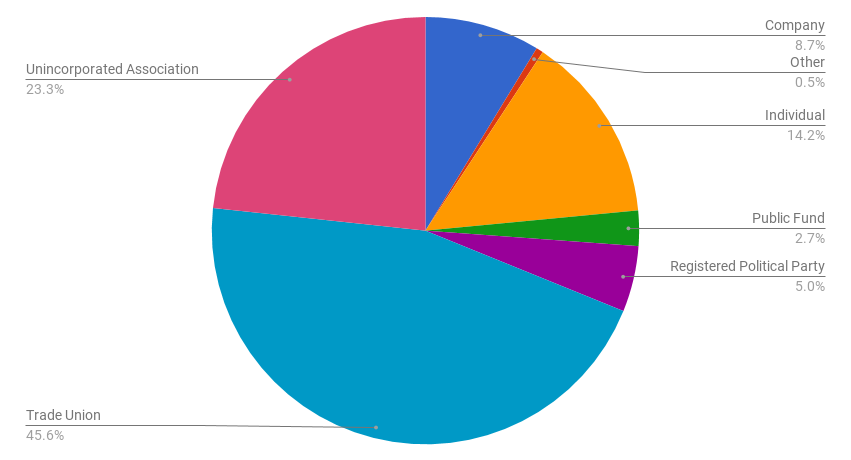 Donations from unincorporated associations are mainly funds passed on from local Labour constituency groups.
Donations from unincorporated associations are mainly funds passed on from local Labour constituency groups.
Trade union support is clearly very important to the party, but it has actually become far less reliant on this.
In 2001, some 80 per cent of all Labour funding came from trade unions. That figure has now been cut by half.
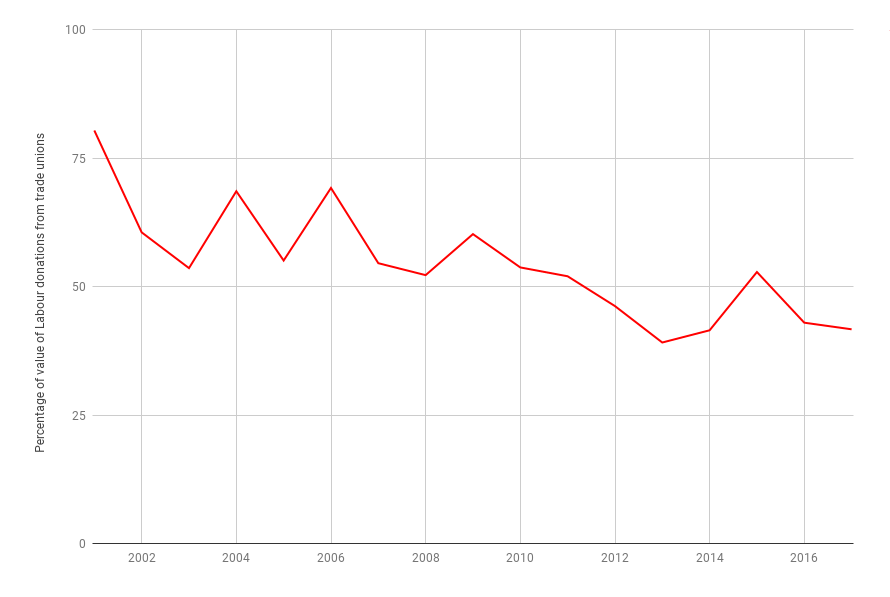
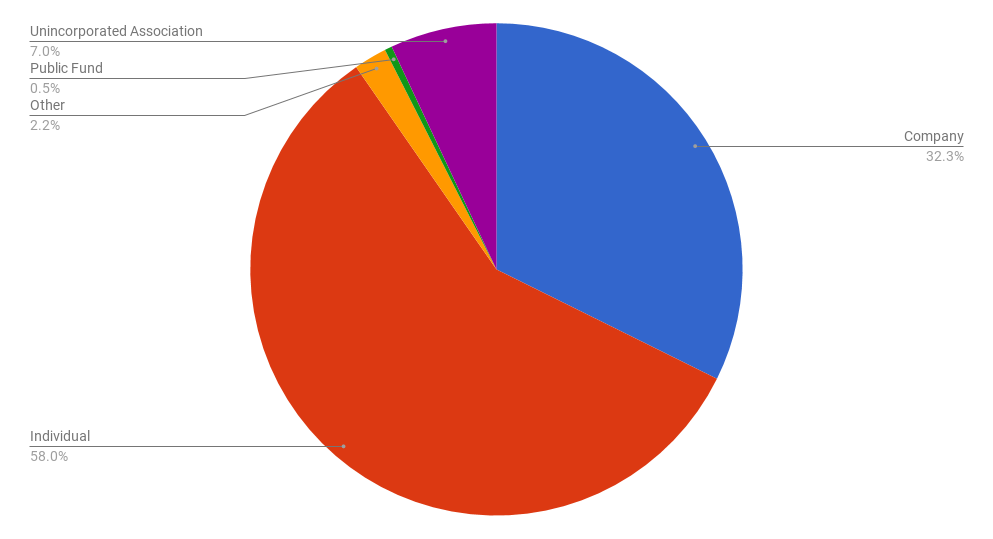 Analysing individual donations is tricky because of the way data is published by the Electoral Commission.
Analysing individual donations is tricky because of the way data is published by the Electoral Commission.
If two separate donations are made under the same name, the data does not confirm whether this is definitely the same person. What’s more, the same person could register different donations under “Joe Bloggs,” “Mr Joe Bloggs,” “Sir Joe F. Bloggs,” and so on. This means there is always a margin of error when analysing who is giving money.
However, more than 11 per cent of all individual Tory donors have registered their donation using honorific titles, such as “Sir,” “Dame,” “Duke,” “Duchess,” “Lord,” and “Lady”. The true proportion is likely to be notably higher because many people do not include these titles in the declarations.
What’s more, donations worth at least half a million pounds make up 16 percent of all the money raised from individual Tory supporters.
The top ten Conservative donors alone have pumped more than £36m into the party since 2001. This accounts for more than 10 per cent of all the money raised by the party since 2001.
Party funding has become a political football. Labour accused the Conservatives of being “as dependent as ever on finance and industry magnates to fund their campaign”. The Conservatives, in turn, claimed Labour’s campaign was “bought and paid for by militant unions”.
The biggest political donors include wealthy business leaders, powerful organisations and members of the nobility. But who are they, exactly? And how much of a stranglehold do they really have over politics?
Political donations are at a record high
Before 2001, political donations were shrouded in secrecy. The parties did not have to say who was funding them, and there were no spending limits during election campaigns.This changed when the Electoral Commission was set up in response to a series of sleaze allegations in the 1990s.
Now days, if you donate more than £7,500 in one year, the political party has to publicly declare this.
The records show that political donations have increased significantly since 2001.
There was a dip after the Conservative-led coalition government was formed in 2010. But that was probably partly as another election was unlikely until 2015, so there was not an immediate need for extra cash.
Donations shot up again in 2014, hitting a record high last year. Altogether, politicians and political parties raised more than £88m.
This graph shows the total amounts that were registered with the Electoral Commission each year, across all the parties. (The 2017 figures are lower because the year is not complete and many donations already received have not been formally registered yet).

Conservatives get a cash surge before elections
There’s a lot of variation when we compare Conservative and Labour funding. Here’s the donations that the parties registered each year.(It’s worth bearing in mind that these Electoral Commission figures only include donations from supporters who have donated at least £7,500. Also, these are just party donations – some donors may have given money to individual parliamentary candidates).
 If we just look at the biggest donations of over £100,000, the difference between the two parties is striking.
If we just look at the biggest donations of over £100,000, the difference between the two parties is striking.The number of large donations going to Labour has remained quite stable over the years. But large donations to the Tories come in peaks and troughs, which roughly align with general elections.

Who raised more for the 2017 election?
Theresa May called the snap election in April, giving the parties 52 days to raise extra money before polling day.During this 52-day period, the Conservatives received nearly three times as much in declarable donations than Labour. In fact, 68 per cent of all declarable donations to any party went to the Conservatives.
This trend can be seen in other elections, too, with the Conservatives raising more during the same 52-period before an election. The notable exception is 2015, when Labour managed to raise about £750,000 more.
 The majority of money raised by political parties, after the 2017
election was called, came from individuals. Private companies and trade
unions made up the next two largest categories of donors.
The majority of money raised by political parties, after the 2017
election was called, came from individuals. Private companies and trade
unions made up the next two largest categories of donors.However, these figures do not include smaller donations that don’t have to be declared.
Labour told FactCheck they raised £5m in small donations over the 52 days before the election. Of that, £4m came from online donations.
We can’t independently verify Labour’s figures but it seems the overall gap between the two main parties’ donations could be much less once small donations are accounted for.
We asked the Conservatives how much they raised in small donations, but have not received a reply. We will update this if they provide the figures.
Is Labour really dependent on Trade Union funding?
Trade union support of the Labour Party has long been a topic of comment and speculation. For instance, shortly before this year’s general election, the Sun wrote that the party “relies” on their financial backing.There’s a lot of truth in this, but the majority of Labour’s funding actually comes from other sources.
Here’s a breakdown of Labour donations registered in 2016.
 Donations from unincorporated associations are mainly funds passed on from local Labour constituency groups.
Donations from unincorporated associations are mainly funds passed on from local Labour constituency groups.Trade union support is clearly very important to the party, but it has actually become far less reliant on this.
In 2001, some 80 per cent of all Labour funding came from trade unions. That figure has now been cut by half.

Are the Conservatives really bankrolled by millionaires?
Last year, 58 per cent of all declarable donations to the Conservatives came from individuals. Considering the threshold for declaration is £7,500, this suggests most of these people are probably fairly wealthy. Analysing individual donations is tricky because of the way data is published by the Electoral Commission.
Analysing individual donations is tricky because of the way data is published by the Electoral Commission.If two separate donations are made under the same name, the data does not confirm whether this is definitely the same person. What’s more, the same person could register different donations under “Joe Bloggs,” “Mr Joe Bloggs,” “Sir Joe F. Bloggs,” and so on. This means there is always a margin of error when analysing who is giving money.
However, more than 11 per cent of all individual Tory donors have registered their donation using honorific titles, such as “Sir,” “Dame,” “Duke,” “Duchess,” “Lord,” and “Lady”. The true proportion is likely to be notably higher because many people do not include these titles in the declarations.
What’s more, donations worth at least half a million pounds make up 16 percent of all the money raised from individual Tory supporters.
The top ten Conservative donors alone have pumped more than £36m into the party since 2001. This accounts for more than 10 per cent of all the money raised by the party since 2001.



